Relativity Space, a start-up based out of Long Beach, California, is preparing to launch the first world’s first 3D-printed low-Earth orbital rocket.

Image Credit: Relativity Space
The company, working out of its Factory of the Future, a 1-million-square-foot former Boeing facility known as ‘The Wormhole’, claims its novel additive manufacturing technique is cheaper and faster than conventional rocket fabrication techniques.
The Terran 1 uses nine Aeon engines to launch and can theoretically carry a commercial payload in the region of around 2800 lbs. (1250 kg) into a low Earth orbit. The engines use liquid oxygen and liquid natural gas, which are leading the way in terms of fuels for propulsion and are ideal for rocket reusability.
Like each stage of the rocket’s structure, Relativity also 3D-prints the engine parts for the Terran 1, making it the largest 3D-printed object to attempt low orbital flight, with 85% of the vehicle’s overall mass being 3D printed.1 The company aims to have this figure somewhere around 95% total 3D-printed mass in future iterations of its space vehicles.1
The World’s Largest Metal 3D-Printers
The innovative 3D-printing method developed by Relativity could potentially revolutionize the future of space travel, as well as additive manufacturing techniques at large.
Early on, the company found that additive manufacturing was a limiting technology as the largest metal 3D printers could only produce parts around one cubic foot in total size. With some of the Terran 1’s parts around 20 feet in length, the company had to practically reinvent the technology to manufacture a rocket capable of space flight.
In its propriety manufacturing facility, Relativity started printing Terran 1 parts and prototypes using conventional vertical additive manufacturing techniques. However, Relativity has since adapted its methods and now prints horizontally using the world’s largest metal 3D printers, known as Stargate, at 7x the speed of the vertical printing method.
The company also developed its own aluminum alloy to optimize production, which requires no fixed tooling.
The change from vertical to horizontal printing meant the company had to adapt the physics of the printhead, which in turn facilitated faster print speeds. Additionally, the team also ensured their method was smart by using machine learning techniques so that mistakes could be rectified in real-time - the Stargate printers get smarter with each print run.
The Relativity team claims that its rockets will only take around 60 days to manufacture as it looks to take on other commercial space companies and find a position in a global economy estimated to be worth around 350 billion US dollars.
Good Luck, Have Fun
Initially scheduled for the 8th of March, the launch, dubbed Good Luck, Have Fun (GLHF), has since been rescheduled and will go ahead on Saturday 11th of March, from Cape Canaveral, Florida.
If successful, the company will proceed with the next phase of Terran manufacturing, Terran R, which will be the first fully reusable 3D-printed rocket that can carry commercial payloads of around 44,000 lbs. (20,000 kg).
By placing large metal 3D printers front and center of Relativity’s enterprise, the company aims to shake up the commercial space industry by showing others it is possible to create viable rockets with alternative manufacturing methods and fewer components.
Conventional rocket manufacturing techniques require hundreds of thousands of parts, often made and assembled by hand, which means years of design iterations and production before a rocket even reaches the launchpad.
With this in mind, and by developing its Factory of the Future and rockets together, Relativity strives to continue the development of its innovative additive manufacturing techniques by focusing on design, speed of production, and quality as key areas of improvement to make 3D-printed rockets the future of space travel.
To watch Terran 1’s first launch on Saturday, the 11th of March 2023, 10 AM EST, join Relativity’s live stream here.
References and Further Reading
- Relativity space (2023) Relativity Space. Available at: https://www.relativityspace.com/
Disclaimer: The views expressed here are those of the author expressed in their private capacity and do not necessarily represent the views of AZoM.com Limited T/A AZoNetwork the owner and operator of this website. This disclaimer forms part of the Terms and conditions of use of this website.